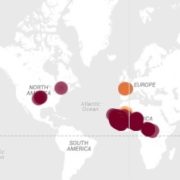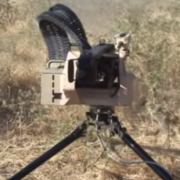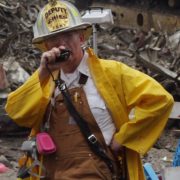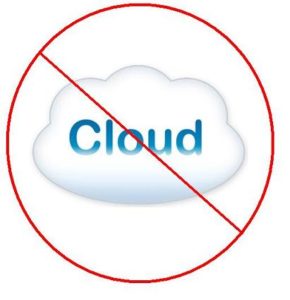“If you know the enemy and know yourself, your victory will not stand in doubt; if you know Heaven and know Earth, you may make your victory complete.”
― Sun Tzu, The Art of War
Fighting an epidemic is surprisingly similar to fighting a human enemy. For example, in both military and anti- epidemic campaigns there is a need for good intelligence, including situational awareness. Just as an army must determine the location of its human enemy, health-care workers must determine where the infections are occurring.
Determining the locations of Ebola infections has been extremely difficult. The affected areas have suffered from long civil wars as well as extreme political corruption. The population has a severe and probably warranted distrust of authorities. Combine this with the fact that Ebola is new in these countries, many people are reluctant to report cases or heed the advice of authorities. Thus, doctors and nurses must “win hearts and minds,” a task familiar to someone who has engaged in counter-insurgency operations.
As in any modern war, computers, networks, and information gathering /sharing play a significant role in battling this deadly disease. Just as generals worry about communicating with their front-line troops, the World Health Organization (WHO) is concerned with exchanging information with the affected population. Since approximately 40% of the affected populations use mobile phones, WHO is considering using text messages for educational outreach as well as a means for people to report cases. Mobile devices are also being used for communication between the outside world and those in quarantine.
In addition to determining the enemy/infection location, commanders of both military and anti-epidemic operations must secure the following information:
- How many enemies /infected victims are there?
- Where is the enemy/infection moving toward?
- Where is the most effective place to put our resources (allied soldiers/doctors & health care workers)?
To answer the above questions, researchers who monitor military activities have utilized artificial intelligence and extensive data mining. For example, the Satellite Sentinel Project (SSP) examined publicly available satellite images and noticed unusual roads in a specific area of Sudan. Based on these images, the SSP accurately predicted a military incursion in this region.
Similar techniques are proving enormously helpful to public healthcare authorities. Let’s say there is a neighborhood in which a suspicious population is reluctant to share information with the authorities. If a satellite image reveals crowded parking lots near a hospital, and public records state there has been a jump in school absenteeism, an intelligence-gathering program can raise the index of suspicion for an outbreak in this specific area. Thus, an alarm can be raised, even when the locals are not cooperative. Indeed, among the new technologies, automated information systems may be the most significant in war against Ebola.
HealthMap may be the most important “smart machine” that gathers, analyzes, and displays information. Every hour, it uses text analysis algorithms to mine data from tens of thousands of Web pages in 15 different languages. The processed information is displayed on a Google Map (see below). HealthMap’s main claim to fame is that is spotted the current Ebola outbreak before WHO did. It has had over a million page views since mid-July.
Click to enlarge

Considering the myriad of sources it draws information from, the simplicity of the displayed information is impressive.
HealthMap is not the only disease monitoring website and computer mapping program. Others include:
- Global Public Health Intelligence Network (GPHIN)
- International Relief and development (IRD) EbolaResponse
- Intelligence Advanced Research Projects (IAR) Global Data on Events, Location and Tone (GDELT) is not a disease monitoring website per se. It collects and analyzes information about all human behavior on a social scale. Based on a story that didn’t even have the word “Ebola” in it, GDELT identified the Ebola outbreak one day before HealthMap did.
Monitoring programs, such as HealthMap, are not only useful in showing what is happening today, but also in predicting the future. Foretelling the path and severity of the Ebola outbreak has been enormously helpful in marshalling and assigning resources.
They have also been helpful in raising an alarm. If it were not for EbolaResponse’s and HealthMap’s catastrophic predictions about what an untreated Ebola outbreak would look like, it is unlikely that the world would have acted as swiftly and as strongly as it did. One researcher compared it to AIDs, which was around at least 20 to 30 years before we became aware of it in the 1980s. Can you imagine how many lives could have been saved if an anti-AIDS effort had begun in the 1960s?
One possible similarity between a military and an anti-outbreak campaign is the effectiveness of post-action outcomes. The United Sates has been very good at meeting objectives in planned military actions. However, our record has been less than perfect once the official war stops. In other words, we “win the war, but lose the peace.” The US supported Afghanistan guerillas who successfully ousted the Soviets from their country. However, we failed to do the necessary follow-up actions in order to build up and stabilize that country. A similar process occurred in Iraq.
Unfortunately, this pattern could very well happen with Ebola. Right now, the world is rallying to contain the outbreak. Once this modern plague is contained, will we continue to aid the affected countries in order to prevent a reoccurrence? In this instance, we hope the anti-Ebola campaign does not resemble our recent military activities.
[layerslider id=”31″]

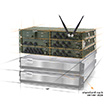

 FORT LEAVENWORTH, Kan. — The U.S. Army unveiled its latest digital command and control system, allowing commanders at higher echelons to make decisions at increasingly lower levels of responsibility.
FORT LEAVENWORTH, Kan. — The U.S. Army unveiled its latest digital command and control system, allowing commanders at higher echelons to make decisions at increasingly lower levels of responsibility.